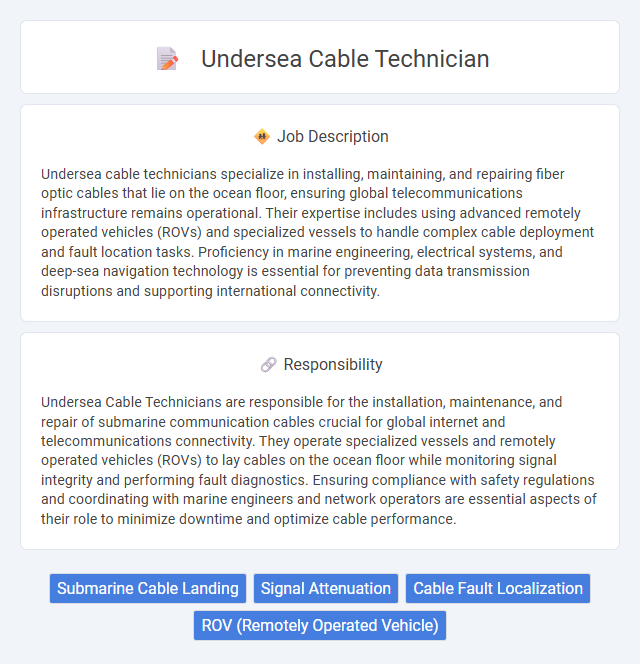
Undersea cable technicians specialize in installing, maintaining, and repairing fiber optic cables that lie on the ocean floor, ensuring global telecommunications infrastructure remains operational. Their expertise includes using advanced remotely operated vehicles (ROVs) and specialized vessels to handle complex cable deployment and fault location tasks. Proficiency in marine engineering, electrical systems, and deep-sea navigation technology is essential for preventing data transmission disruptions and supporting international connectivity.
Undersea Cable Technicians likely face physically demanding and mentally challenging environments, often working in isolated and high-pressure conditions. Individuals with strong problem-solving skills, resilience, and a comfort with technical and marine settings may be well-suited for this role. Those who find prolonged periods away from shore or variable weather conditions difficult could find this career less suitable.
Qualification
An Undersea Cable Technician requires specialized training in underwater operations, electrical engineering, and fiber optic technology, typically supported by certifications in diving and maritime safety. Proficiency in cable installation, maintenance, and repair under extreme oceanic conditions is essential, along with experience using sophisticated diagnostic equipment. Strong problem-solving skills and physical fitness to work in challenging underwater environments enhance job performance.
Responsibility
Undersea Cable Technicians are responsible for the installation, maintenance, and repair of submarine communication cables crucial for global internet and telecommunications connectivity. They operate specialized vessels and remotely operated vehicles (ROVs) to lay cables on the ocean floor while monitoring signal integrity and performing fault diagnostics. Ensuring compliance with safety regulations and coordinating with marine engineers and network operators are essential aspects of their role to minimize downtime and optimize cable performance.
Benefit
Undersea cable technicians likely enjoy competitive salaries due to the specialized nature of their work and the technical expertise required. They probably receive benefits such as travel opportunities and exposure to cutting-edge maritime technology. Job stability and career growth prospects may be strong, given the increasing global demand for undersea communication infrastructure.
Challenge
Undersea cable technicians likely face significant challenges working in harsh marine environments where precision and safety are critical. The complexity of repairing and maintaining underwater cables is probably heightened by unpredictable weather and deep-sea conditions. These factors may increase the difficulty of ensuring uninterrupted global communications and data transfer.
Career Advancement
Undersea Cable Technicians can advance their careers by gaining expertise in fiber optic technology, network maintenance, and underwater repair methods. Certification in specialized equipment operation and project management opens opportunities for supervisory or engineering roles within telecommunications companies. Continuous training in cutting-edge cable systems enhances prospects for higher salary brackets and leadership positions in global infrastructure projects.
Key Terms
Submarine Cable Landing
Undersea Cable Technicians specializing in Submarine Cable Landing are responsible for installing and maintaining high-capacity fiber optic cables that connect continents through underwater routes. Their expertise includes managing the cable landing sites where cables are brought ashore, ensuring secure termination and integration with terrestrial networks. Proficiency in marine operations, cable jointing, and real-time troubleshooting is essential to minimize downtime and maintain global communications infrastructure.
Signal Attenuation
Undersea cable technicians specialize in maintaining and repairing subsea fiber optic cables, ensuring minimal signal attenuation for optimal data transmission. Signal attenuation in undersea cables occurs due to factors such as fiber impurities, physical damage, and water pressure, requiring precise testing and calibration by technicians. Advanced diagnostic tools and on-site repairs are crucial to restoring signal strength and preserving the integrity of global communication networks.
Cable Fault Localization
Undersea Cable Technicians specializing in Cable Fault Localization employ advanced diagnostic tools such as Time Domain Reflectometry (TDR) and Optical Time Domain Reflectometry (OTDR) to precisely identify anomalies in fiber optic and coaxial cables beneath ocean floors. These experts analyze signal loss patterns and measure cable impedance to pinpoint fault locations, facilitating swift and accurate repairs that minimize downtime and data loss. Mastery in interpreting complex electronic signals and coordinating with maritime vessels ensures seamless restoration of critical underwater communication infrastructure.
ROV (Remotely Operated Vehicle)
Undersea Cable Technicians utilize ROVs (Remotely Operated Vehicles) to inspect, install, and repair submarine communication cables on the ocean floor. ROVs are equipped with advanced cameras and robotic arms that enable precise manipulation and real-time monitoring in deep-sea environments. Mastery of ROV operation enhances cable integrity and ensures uninterrupted global telecommunications networks.
 kuljobs.com
kuljobs.com